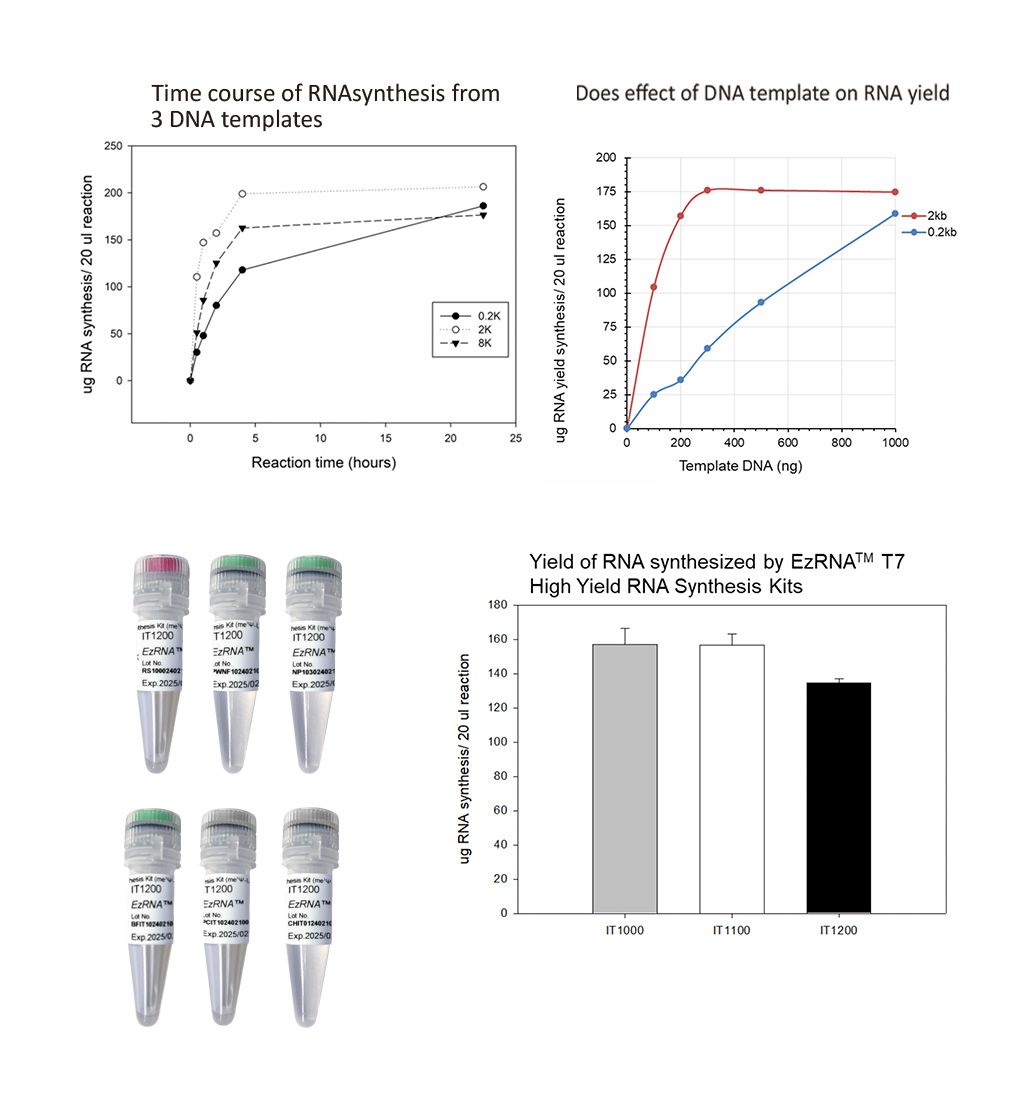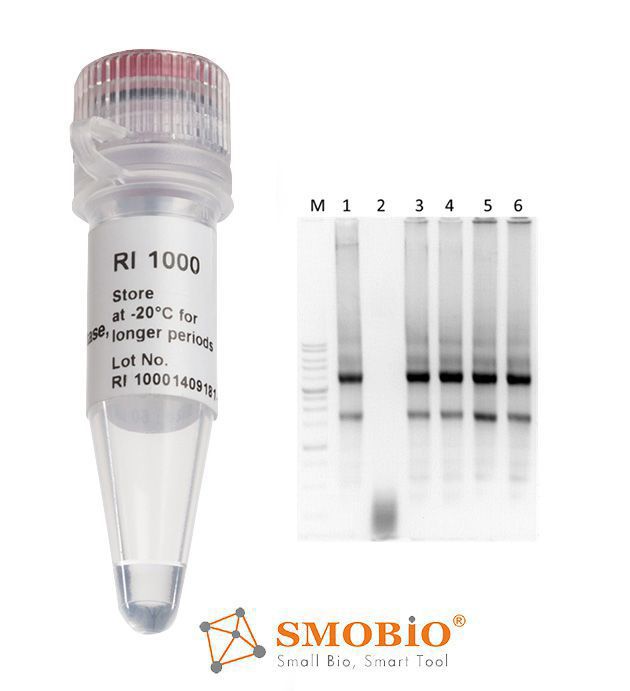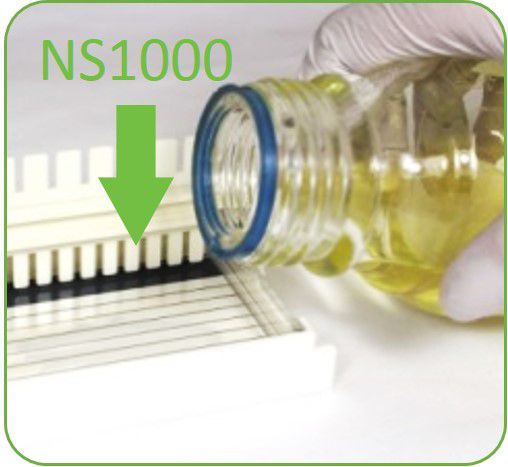Description
The EzRNA™ RNA Capping System is a user-friendly product for post-transcriptional RNA modification. Both Vaccinia Capping Enzyme and 2’-O-Methyltransferase are included in the package, which are able to perform in a single reaction. The Vaccinia Capping Enzyme attach 7-methylguanylate cap (m7Gppp, Cap-0) to the 5' end of RNA to form m7Gppp5'N-RNA (Cap-0 RNA). The 2'-O-methyltransferase utilizes Cap-0 RNA as a substrate, employing S-adenosine methionine (SAM) as a methyl donor to methylate 2' -OH of the first nucleotide at the 5' end of Cap-0 RNA, resulting in the formation of Cap-1 RNA.
Features
2’-O-Methyltransferase included for Cap-1 RNA
High capping efficiency
High stability
RNase inhibitor is included to enhance the stability of capping reaction
Application
Generation of 5’Cap-0 (m7Gppp) and Cap-1 (m7GpppNm-) RNA by enzymatic reactio
mRNA synthesis for in vitro translation
Gene expression studies
mRNA vaccine development and therapeutics
Generation of 5’Cap-0 (m7Gppp) and Cap-1 (m7GpppNm-) RNA by enzymatic reactio
mRNA synthesis for in vitro translation
Gene expression studies
mRNA vaccine development and therapeutics
Storage
-20°C for 24 month
Highly expression of eGFP-mRNA in mammalian cells

The eGFP-mRNA was generated utilizing the SMOBIO EzRNATM T7 High Yield RNA Synthesis Kit (Ψ-UTP) in conjunction with the EzRNATM RNA Capping System. Subsequently, eGFP-mRNA was transfected into HeLa cells using Lipofectamine 3000 for an incubation period of 18 hours. Higher than 90% transfection efficiency was observed.
Figure and data
Contents
Components | Volume |
Vaccinia Capping Enzymes | 50 μl |
2´-O-Methyltransferase | 50 μl |
10X Capping Buffer | 100 μl |
S-adenosylmethionine (SAM) (32 mM) | 50 μl |
RNase Inhibitor (20 U/μl) | 50 μl |
GTP (10 mM) | 50 μl |
Nuclease-Free Water | 1 ml |
Storage
-20°C for 12 month
What is Cap-0 and Cap-1?
Cap-0 denotes a N7-methyl guanosine linked to the 5′ nucleotide via a 5′ to 5′ triphosphate linkage, often referred to as m7G cap or m7Gppp- in literature. Within cells, the Cap-0 structure is crucial for the efficient translation of mRNA carrying the cap.
An additional methylation on the 2′O position of the initiating nucleotide results in Cap-1, also known as m7GpppNm-, where Nm signifies any nucleotide with a 2′O methylation. Cap-1 has been demonstrated to play a significant role in circumventing the cellular innate immune response in vivo.
In summary, Cap-0 is the basic cap structure found in most eukaryotic mRNA, Cap-1 represents a modified form with additional methylation at the first transcribed nucleotide. These cap structures contribute to mRNA stability, translation initiation, and regulation of gene expression in eukaryotic cells.
Can the Cap analogs be used in capping reaction when using the EzRNATM RNA Capping System?
No, the EzRNATM RNA Capping System utilizes Vaccinia Capping Enzyme, SAM, and GTP to form a Cap structure on 5′ triphosphate RNA following in vitro transcription.
In contrast, Cap analogs like GpppG, m7GpppG, m7GpppA, and anti-reverse cap analogs (ARCA) are synchronously used in in vitro transcription (IVT) reaction, where the Cap analog is directly incorporated into the transcript as the initial nucleotide at the 5′ end.
Is it necessary to have a denaturation step for IVT RNA before enzymatic capping using vaccinia capping enzyme?
It is not absolutely necessary but recommended to conduct a denaturation step for IVT RNA before enzymatic capping using the Vaccinia capping enzyme.
Denaturation helps to unfold the RNA secondary structures and allows the capping enzyme to access the 5' triphosphate end of the RNA efficiently for capping. Denaturation is typically achieved by heating the RNA sample at an elevated temperature, often around 65°C, for a short period (5-10 mins), followed by rapid cooling on ice to prevent reannealing of the RNA strands. This denaturation step ensures optimal capping efficiency and promotes the successful addition of the cap structure by the capping enzyme.
Is it possible to perform both IVT and RNA capping reactions in one tube?
Yes, it is possible to carry out both IVT and RNA capping reactions in one tube when utilizing the EzRNATM RNA Capping System alongside the EzRNATM T7 High Yield RNA Synthesis Kit. It's important to clarify that this doesn't imply simultaneous performance of IVT and capping reactions; rather, the IVT reaction must precede the capping reaction.
For users intending to perform a one-tube reaction, we suggest adding nuclease-free water directly into the tube after completing the IVT reaction and then introducing the components of the RNA capping system to produce capped RNA. Based on our experience, a 6x dilution (e.g., adding 100 μl nuclease-free water to the IVT reaction tube) is suitable for conducting IVT and capping reactions in one tube when utilizing control DNA (included in the EzRNATM T7 High Yield RNA Synthesis Kit) as the template for generating capped RNA.
Additionally, it should be noticed that if the RNA is known to have a relatively complex or tight secondary structure, we still recommend using the standard method, where IVT and capping are carried out in two separate tubes, with a denaturation step required in between.
What's major factor affecting RNA capping efficiency using vaccinia capping enzyme?
The efficiency of RNA capping when using the Vaccinia capping enzyme is primarily influenced by the structural integrity and accessibility of the RNA molecule.
If the RNA has a complex secondary structure or regions prone to forming stable secondary structures, it can hinder the capping enzyme's access to the 5' triphosphate end, leading to reduced capping efficiency.
Therefore, it is crucial to ensure that the RNA substrate is properly folded and accessible for capping in order to optimize efficiency. Choosing a suitable or less structured 5'UTR may enhance capping efficiency by facilitating better access for the capping enzyme to the 5' end of the RNA molecule.
What's the advantage of capped RNA synthesized using vaccinia capping enzyme over capped RNA synthesized using a cap analog?
Capped RNA synthesized using Vaccinia capping enzyme offers the advantages of a natural cap structure, high efficiency, post-transcriptional versatility, and ease of use.
These features make it a preferred choice for applications requiring capped RNA, such as in vitro translation, cell transfection, and mRNA-based therapeutics, where optimal translational efficiency and biological relevance are desired.
For prevention of RNase contamination, it is highly advised to wear gloves, utilize nuclease-free tubes and reagents, and meticulously clean pipettes and bench surfaces throughout the procedure.
Prior to the capping reaction, it is crucial to guarantee the purification of RNA, which should be suspended in nuclease-free water devoid of EDTA and salts.
Subjecting the RNA to heating at 65°C for 5 minutes before initiating the capping reaction eliminates secondary structures present at the 5´ end of the transcript. Increase the duration to 10 minutes for RNA known to have highly structured at 5’ ends.
Due to its instability at pH 7–8, 37°C, please dilute SAM immediately before initiating the reaction.
To minimize loss due to the high viscosity of the vaccinia capping enzyme solution, please follow these guidelines:
a.) Use low-retention pipette tips: Low-retention pipette tips help reduce residue and ensure accurate transfer, minimizing solution loss.
b.) Aspirate gently: When drawing the solution, gently touch the liquid surface to prevent excessive uptake and reduce waste.
[IT1000] EzRNA™T7 High Yield RNA Synthesis Kit, 50 RXN
Application
Generation of RNA from T7 promoter-driven DNA sequences
Suitable for subsequent cap-0 and cap-1 modification
[IT1100] EzRNA™T7 High Yield RNA Synthesis Kit (Ψ-UTP), 50 RXN
Application
Generation of RNA from T7 promoter-driven DNA sequences
Suitable for subsequent cap-0 and cap-1 modification
[IT1200] EzRNA™ T7 High Yield RNA Synthesis Kit (me1Ψ-UTP), 50 RXN
Application
Generation of RNA from T7 promoter-driven DNA sequences
Suitable for subsequent cap-0 and cap-1 modification
FluoroVue™ Nucleic Acid Gel Stain
Excellent for in-gel staining
Sensitivity up to 0.14 ng (DNA) or or 1 ng (total RNA)
A safe alternative to EtBr
Suitable for blue or UV light

![[RC1000] EzRNA™ RNA加帽系統, 50 RXN](/web/image/product.template/481/image?unique=d11b009)


